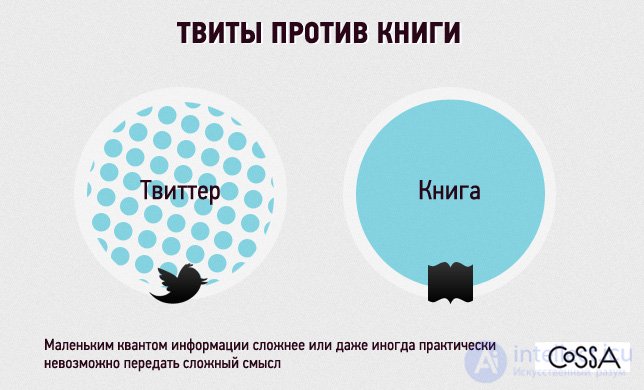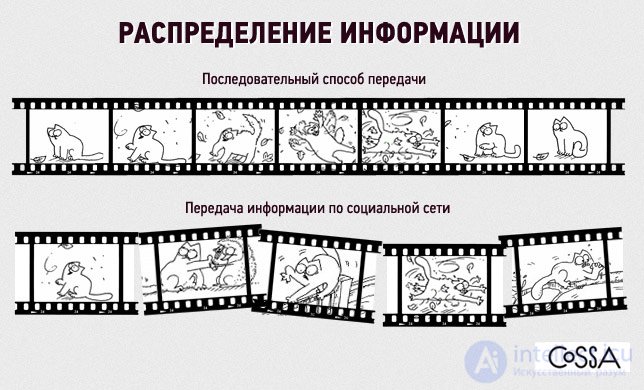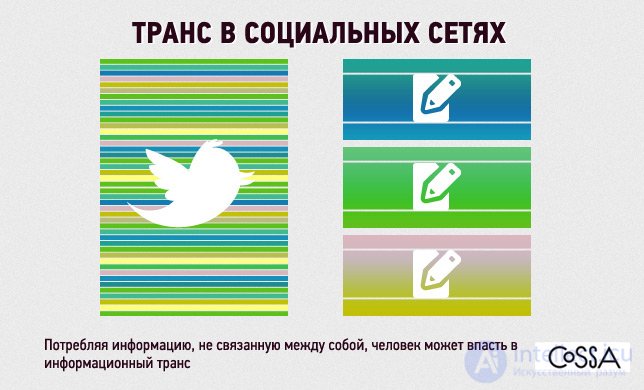Lecture
Marshal McLuhan (1911–1980) studied, among other things, how media changes people and the world.
Here are two basics that he highlights:
1. Expansion
The meaning of any tool is to expand the capabilities of the human body. Hunting bow increases the chances of a hunter. The machine expands the ability to move. Speech expands the possibility of feelings - with the help of stories you can save memories and evoke emotions with a story. The phone expands the ability of speech. Social media expands the soul of man. Marshal McLuhan would call it the nervous system. With the advent of man on the Internet, his nervous system went beyond the human body. Now it is outside the body.
The person shapes the instrument, in response the instrument changes the person. People made a cell phone, - changed our speech, the rhythm of life and the possibility of movement.
With the advent of the Internet, psychologists have noticed a disorder in people called the “time structure disorder.” If earlier the person’s schedule was determined by daylight, now time depends on the information received. Marshal McLuhan said that, with the advent of electric light, the space around people was rearranged, people left the rhythms of day and night, a new world, new connections and opportunities appeared.
If before the invention of electricity, people went to bed, when the sun sets, then, with the advent of the Internet, people go to bed, when the news ends in the tape, or they close the browser.
The Internet has deformed and, one might even say, killed time. Time began to be in direct dependence on the consumption of *** information. If there is one person in the tape, reading the update will take five minutes, and if there are a hundred people, then it will be all night.
In addition to the "disorder of the structure of time", modern users still have a "disorder of the structure of information." Now people have started to consume *** a large number of small quanta of information, and a smaller number of large texts. Sometimes they have a desire to skip a big paragraph. Knowing this, Western Internet media sometimes write paragraphs that consist of one sentence.

A small quantum of information is more difficult, or even sometimes practically impossible to convey a complex meaning.

Top - a consistent way to transfer information, below - an example of how information is transmitted in a social network. Small quanta of information from various sources are intermingled. Information on the Internet users receive small portions. In the network are millions of bits of text and pictures. There are less and less big structured stories.
In this regard, consciousness is forced to link inconsistent quanta of information into one story. Thereby completing additional work on the installation, when it could spend it on extracting meaning. The brain is forced to perform additional work of connecting the fragments into a single fabric.
Prof. Susan Greenfield:
In the network there is the possibility of losing the ability to think consistently, structurally. There is no chronological sequence on the Internet. Because if you know a lot of things, but do not do mental work to connect them with each other, they remain a fragmented set of facts.
1. Meanings reduced
2. Consciousness is forced to do additional work on the installation.
Psychologists say that because of the long-term use of social networks, people lose the habit of drawing long-term conclusions and being responsible for their actions because they don’t see the connection between business and communication. When a lot of fragmented unstructured information enters the brain, it is difficult for a person to draw conclusions, because you have to collect individual parts and form them in history. The brain begins to be lazy - why think for yourself if you can wait for a comment or a new post. Why draw conclusions if this post now goes down, and you can switch your attention to a new message.
Scenarios, stories, articles are based on a three-act structure. Any work has a beginning, middle and end. This structure is called the "arch of history."
Psychologists say that a person’s brain feels pleasure and relief when it falls into the “arch of history”. Information is perceived easier when the mind clearly feels the structure of the story.
When the brain enters the arch of history, it relaxes, it is led, it does not waste energy on editing, but only on extracting meaning.
In the "arch of history":
1. Causal relationships are visible.
The reader clearly sees and understands that the hero on the hundredth page of the book is getting married, because at the first he decides to go into battle with the dragon.
2. Do not waste energy and time on the installation of history. Because of this, the brain gets pleasure and is relieved.
Serial culture works with the redistribution of human attention. The time during which a person is able to hold him on one thing is reduced, but the number of such objects and the total time that a person eventually spends consuming them increases.
LJ tape on the right. Messages more in volume and within themselves have a structure that facilitates perception. And each message carries more units of meaning than fragments or surface icebergs on social networks. On the right is a ribbon of disparate messages in the social network.
The need for information that is not related to each other, a person can fall into an informational trance.

The brain is relieved when it enters the arch of history. Reading stories out of trance.
You can remove the brain from a trance by suggesting a structured message to a person in a stream of shreds. The brain enters the structure of the message, is experiencing psychological relief and comes out of trance. And the man goes out of the Internet.
If you flip through the tape in VKontakte or Facebook all day, it will be very difficult to stop. For example, viewing the next movie “Citizen Poet” or another meaningful story will help you to get out of a bad infinity - the movie has a beginning, middle, end, thought out and meaning.
The news feed is disorienting Internet users who have no established view of the events and a personal understanding of where and why it is going.
Like colorful magnets, messages from different sources disorient the user in the semantic space, while the arch of the story leads exactly to the goal through the necessary steps.
Planning is one example of the health of structured information. When a person knows milestones on the way, he knows where he is going, it is difficult to knock him down by third-party semantic flow. An example is political PR in the USSR, five-year plans in the USSR.
In psychology, there is a whole direction- treatment stories. People are taught to perceive and compose stories correctly, as a result of which a person is trained to be able to think consistently and find meanings.
Clarissa Pinkola Estes - psychoanalyst of the Jungian school and cantador (hereditary professional narrator) of the Latin American tradition - the author of the book “Running with the Wolves. Female archetype in myths and legends, one of the main books in the Jungian tradition, considering the archetype of women.
One of the activities of Clarissa Estes is “history therapy”.
At one time, her broadcasts were broadcast to hot spots around the world.
Fairy tales are a medicine. They own me since I heard my first fairy tale. They have healing power, not forcing us to do, to be, to act - just listening to them is enough.
Fairy tales contain tools to correct or revive any lost spiritual spring. Fairy tales give rise to excitement, sadness, questions, aspirations and understanding, which spontaneously raise the desired archetype to the surface.
We enter the tale through the door of the inner ear. When telling a fairy tale, the sound of her words affects the auditory nerve, which crosses the base of the skull and enters the brain stem below the pons. From there, the auditory impulses are transmitted to the top, to the consciousness, or, as some argue, to the soul - depending on the relationship with which you listen.
According to the observations of Vasily Gatov and Ilya Oskolkov-Tsentsiper, in the lecture “The Influence of Socrates on Modern Media” all people became media.
Earlier, in order to broadcast to a large audience, a printing plant was needed. With the development of social networks, each person has become a media.
Social networks have changed people so much that Internet users have become living stories. People themselves have become TV shows themselves.
Vasily Gatov and Ilya Oskolkov-Tsentsiper in the lecture “The Influence of Socrates on Modern Media”:
Everybody has a new profession born - a media director. A person who is able to stretch communication at once to all media, channels and give it out in the necessary portions (in content and quantity) in order to achieve the fulfillment of the task. Invest in short messages large layers of information, create memorable memes and myths.
People on social networks watch TV shows that happen to their friends or brands.
Artemy Lebedev turned his entire studio into a serial. At one time, when the Norwegian Forest conducted the press service, news about what was happening in the backstage of the Studio, which he wrote every day, was more popular than the pages with the works of the studio.
Now Nikolai Danilov is conducting the “Photo of the Day” category on the Studio’s website - also a kind of series. This year, Lebedev has a new heading “Stripes” on the website - short comics that are drawn by Studio employees every day.
In the 90s, Lebedev created the virtual Katya Detkin and led the series on her behalf. Katya wrote angry reviews on all new sites, except for sites created by Lebedev himself. Then Subject reported that she died and everyone was upset.
All people began to enter the information space in small series. The man began to quantize in a social network, showing different sides of his life.
A person can effectively build his life if he understands himself, his purpose, his form, his body. New body in a social network - the body of the series.
If a person understands how stories are built and how they develop, then he will act effectively in a new life environment. Otherwise - it will stagnate.
People had a real need for stories. Short, solid stories, with a beginning, middle and end. This genre will always be popular because it facilitates the work of the brain and leads a person.
With the advent of the Internet, the man became a TV series, he became quantized in space.
Moreover, a person does not show himself entirely, but shows various aspects of his personality, often not always true, but superficial. Sometimes a person acts on the face of a role mask.
In order to develop harmoniously, it is necessary to understand that the personality and the profile are different structures. Understanding the laws of the development of dramatic stories will allow a person not to mark time, but to move and develop.
On the Internet, information is fed in small portions - information quanta, mixed together.
A person has to spend extra energy on mounting pieces into one story, whereas he could spend this time and energy on extracting meaning.
Due to the long-term use of social networks, people have lost the ability to draw long-term conclusions and take responsibility for their actions - because they don’t see the connection between the messages.
Structured messages are based on the "arch of history" and have a beginning, middle and end. Getting into the "arch of history" the brain experiences relief and pleasure. Such stories can give a person relief, and restore the ability to think consistently.
Comments
To leave a comment
SMM Social Media Promotion
Terms: SMM Social Media Promotion